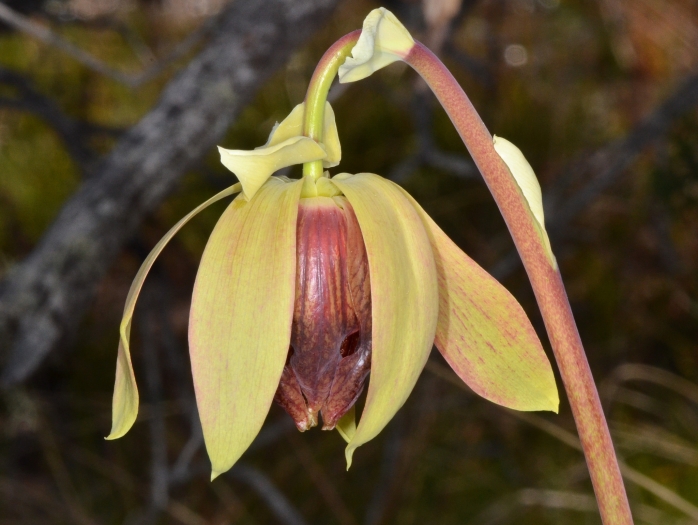California Pitcher Plant
(Darlingtonia californica)
California Pitcher Plant (Darlingtonia californica)
/
/

Don Loarie
CC BY 4.0
Image By:
Don Loarie
Recorded By:
Copyright:
CC BY 4.0
Copyright Notice:
Photo by: Don Loarie | License Type: CC BY 4.0 | License URL: http://creativecommons.org/licenses/by/4.0/ | Rights Holder: Don Loarie | Publisher: iNaturalist | Date Created: 2012-05-27T16:07:05-07:00 |












Estimated Native Range
Summary
Darlingtonia californica, commonly known as California Pitcher Plant or Cobra Lily, is a perennial herbaceous carnivorous plant native to the serpentine soils of cool, shaded mountain streambanks and seeps in Northern California and Oregon. It typically inhabits nutrient-poor, acidic bogs and wetlands where cold water percolates. The plant is characterized by its tubular, green to red-veined leaves that are modified into pitfall traps, resembling a rearing cobra with a forked leaf – resembling a serpent’s tongue – used to lure and trap insects for nutrients. The California Pitcher Plant can reach up to 3 feet in height and blooms with purplish-red flowers in the spring and early summer, though the flowers are not particularly showy compared to the dramatic foliage.
The Cobra Lily is notable for its unique adaptation to nutrient-poor environments, its striking leaf form, and its role in supporting a specialized ecosystem. It is used in cultivation primarily as a curiosity and conversation piece in bog gardens and among carnivorous plant enthusiasts. It requires consistently moist, acidic soil and cool root temperatures, mimicking its native bog conditions. Full sun to partial shade is preferred, with protection from intense afternoon heat. The plant is sensitive to high soil temperatures and does not tolerate drought. It can regenerate from roots after fire, which is a common occurrence in its native habitat. While it produces its own digestive enzymes, it has also developed a mutualistic relationship with certain bacteria that help digest captured prey. Potential problems include root rot if the soil is not well-drained or if the water is too warm.CC BY-SA 4.0
The Cobra Lily is notable for its unique adaptation to nutrient-poor environments, its striking leaf form, and its role in supporting a specialized ecosystem. It is used in cultivation primarily as a curiosity and conversation piece in bog gardens and among carnivorous plant enthusiasts. It requires consistently moist, acidic soil and cool root temperatures, mimicking its native bog conditions. Full sun to partial shade is preferred, with protection from intense afternoon heat. The plant is sensitive to high soil temperatures and does not tolerate drought. It can regenerate from roots after fire, which is a common occurrence in its native habitat. While it produces its own digestive enzymes, it has also developed a mutualistic relationship with certain bacteria that help digest captured prey. Potential problems include root rot if the soil is not well-drained or if the water is too warm.CC BY-SA 4.0
Plant Description
- Plant Type: Shrub, Herb
- Height: 2-3.5 feet
- Width: 0.6-0.75 feet
- Growth Rate: Slow
- Flower Color: Green, Red, Yellow
- Flowering Season: Spring, Summer
- Leaf Retention: Evergreen
Growth Requirements
- Sun: Full Sun, Part Shade
- Water: Aquatic
- Drainage: Medium
Common Uses
Water Garden
Natural Habitat
Cool, shaded mountain streambanks and seeps in Northern California and Oregon, typically in serpentine soils of nutrient-poor, acidic bogs and wetlands
Other Names
Common Names: Cobra Lily, Calf’s Head, Cobra Plant
Scientific Names: , Darlingtonia californica, Chrysamphora californica, Darlingtonia californica f. californica, Darlingtonia californica f. viridiflora, Darlingtonia rediviva,
GBIF Accepted Name: